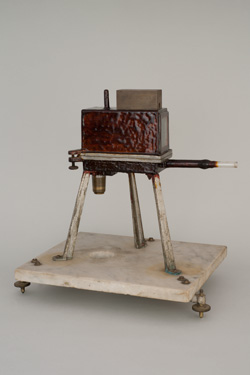
- Name:
- Microbalance
- Date:
- Unknown
- Dimensions (H x W x D, cm):
- 0.0 x 0.0 x 0.0
- Associated Lecturer/s
-
Kerr Grant
Joan Treasure Radford
An original Kerr-Grant Microbalance, modified by E.J.Hartung
This balance was invented in the chemistry department by Bertram Dillon Steele, later first Professor of Chemistry at the University of Queensland 1910-1930, in collaboration with Professor Kerr Grant, Physics. The design was widely used by other chemists, including Masson's mentor, Professor Ramsay, working in London on newly discovered rare gases (especially Radon), and Professor Hartung (item 9a) in Melbourne, investigating the chemistry of the decomposition of silver salts in photographic processes.
The principle of the microbalance was to measure the change in density of a gas by the shift in the balancing beam due to a change in pressure of the gas in the balance case. The quartz balancing beam was made by Bertram Steele who was particularly skilled in glassblowing. A typical glassblowing torch of the period and the foot bellows used to pump air to the torch are shown in items 17 and 79.
A similar quartz beam is shown in item #13, which is the beam of the Aston microbalance based on the Steele/Grant instrument, and described by F.W. Aston, the inventor of the mass spectrometer. The bulb at one end of the beam contained a fixed amount of air, so that a change in the pressure of gas in the balance case changed the buoyancy of the beam, yielding a displacement in the beam which could be measured. By this means, differences in weight of about 10 nanogram could be measured, in amounts of up to 0.1 gram. Such differences are significant the increase in weight of a metal sample due to surface oxidation (Steele's interest) in the weight loss due to radioactive decay of Radium (Ramsay's work), and in the estimates of density change due to the isotopic distribution of Neon (Aston).
R.D. Steele and Kerr Grant, "Sensitive Microbalance and a New Method of Weighing Minute Quantities", Proc. Roy. Soc. (A) 1909, 82, 579 (see Figs 1, 2, 3)
R.W. Gray and W. Ramsay, Proc. Roy. Soc. (A) 1911, 84, 556, "The Density of Niton (Radium Emanation) and the Disintegration Theory"
F.W. Aston, "A Simple Form of Micro Balance for Determining the Densities of Small Quantities of Gases", Proc. Roy. Soc. (A) 1914, 89, 439
